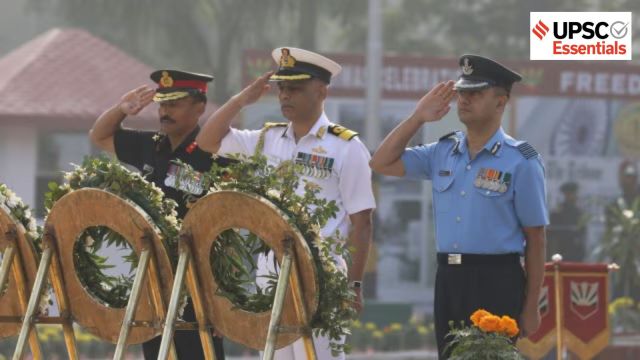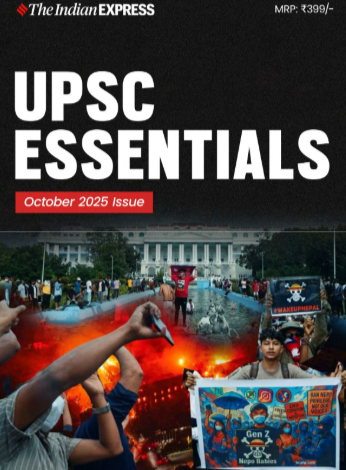© IE Online Media Services Pvt Ltd
Latest Comment
Post Comment
Read Comments
 Group Captain Samrat Chaudhary, Station Commander of Advance Headquarters; Commodore Ajay Yadav, Naval Officer-in-Charge for West Bengal (in white); and Brigadier Ajay Kumar Das, Station Commander of Kolkata Military Station, participated in the wreath-laying ceremony during Vijay Diwas celebrations at Eastern Command Headquarters, Fort William, on Monday, December 16, 2024. (Express photo by Partha Paul)
Group Captain Samrat Chaudhary, Station Commander of Advance Headquarters; Commodore Ajay Yadav, Naval Officer-in-Charge for West Bengal (in white); and Brigadier Ajay Kumar Das, Station Commander of Kolkata Military Station, participated in the wreath-laying ceremony during Vijay Diwas celebrations at Eastern Command Headquarters, Fort William, on Monday, December 16, 2024. (Express photo by Partha Paul)— Mohammad Asim Siddiqui
(The Indian Express has launched a new series of articles for UPSC aspirants written by seasoned writers and scholars on issues and concepts spanning History, Polity, International Relations, Art, Culture and Heritage, Environment, Geography, Science and Technology, and so on. Read and reflect with subject experts and boost your chance of cracking the much-coveted UPSC CSE. In the following article, Mohammad Asim Siddiqui reflects on India’s pivotal role in the 1971 War and the Birth of Bangladesh.)
Every year on 16 December, both India and Bangladesh celebrate Vijay Diwas (Victory Day) to mark India’s decisive victory over Pakistan in the 1971 war, which also led to the birth of Bangladesh. The Vijay Diwas celebration by the Indian Army’s Eastern Command, headquartered in Fort William, Kolkata, is one of the largest military events in South Asia.
Despite initial uncertainty, eight Indian military veterans of the Bangladesh Liberation War of 1971 went to Dhaka while eight officers of the Bangladesh Army arrived in Kolkata to participate in the Vijay Diwas celebrations in the two countries.
Let’s take a look at factors that led to the 1971 war, and how India played its part in the liberation of Bangladesh.
The war began on 3 December 1971 when Pakistan launched air strikes on many military bases in the northwestern parts of India. The Indian Air Force retaliated by launching air strikes. With snow-covered Himalayas ruling out the possibility of Chinese help for Pakistan, the weather was favourable for India. The Indian Navy also started a move towards Karachi.
In the eastern part, the Indian Air Force was assisted by Mukti Bahini – a 20,000-strong guerrilla force of Bangladeshi soldiers and civilians trained by India – which knew the geography of East Pakistan well. The short and intense war was fought on both the Eastern and Western fronts for over 13 days.
On 16 December, Pakistan was forced to sign the Instrument of Surrender which ended the war and gave birth to the independent nation of Bangladesh. Lt Gen. A.A.K. Niazi, Commander of the Pakistan Eastern Command, signed the Instrument of Surrender in the presence of Lt. Gen. Jagjit Singh Aurora, General Officer Commanding-in-Chief of the Indian Eastern Command, in Dacca (now Dhaka).
The Instrument of Surrender involved the surrender of “all Pakistan Armed Forces in Bangla Desh to Lieutenant-General Jagjit Singh Aurora”. Approximately 90,000 Pakistani soldiers were taken as prisoners of war, the largest number of prisoners since World War II, marking a significant military and political victory for India and Bangladesh.
A number of factors contributed to Bangladesh’s 1971 Liberation War, including the troubled history of Partition, skirmishes over the border and the 1965 India-Pakistan war, claims of the two countries over Kashmir, and the different political paths adopted by the two countries where India became a thriving democracy while Pakistan’s political landscape was dominated by its conservative elements and the Army. These factors can be analysed around the following key points.
Ethnic, linguistic and cultural factors: Although East Pakistan (now Bangladesh) and West Pakistan (present-day Pakistan) practiced common faith, the imposition of Urdu by West Pakistan on Bengali-speaking East Pakistanis caused serious fissures in their relationship.
East Pakistanis, who were considered closer to India and Hinduism, often faced prejudice, discrimination and insults at the hands of West Pakistani elites and leaders. In his book Friends Not Masters: A Political Autobiography (1967), former President of Pakistan Mohammad Ayub Khan, believing East Pakistanis were of “original Indian races”, observed “considerable Hindu cultural and linguistic influence” on them.
Demand for regional autonomy: In the mid-1960s, leaders such as Sheikh Mujibur Rahman, also known as the founder of Bangladesh, actively began protesting against such policies and helped form the Awami League. Mujibur Rahman’s Six-Point Programme, advocating regional autonomy for East Pakistan, was rejected by the West Pakistani leadership. He was charged with promoting secessionist tendencies and arrested. However, the Ayub Khan government could not prove the charges which turned the sympathies of the people for Rahman, further affecting the relations between the two regions.
The 1970 general elections: Mujibur Rahman contested the December 1970 elections on the basis of the popularity of his Six-Point Programme among the Bengali population. Surprising the central leadership, his party won 160 out of 162 seats in East Pakistan but none in West Pakistan. The other dominant party, Pakistan People’s Party of Zulfiqar Ali Bhutto, was victorious in 81 of 138 seats in West Pakistan.
The election results highlighted the serious differences between East and West Pakistan. With an absolute majority in the National Assembly (167 out of 300 seats overall), the Awami League was entitled to form the federal government. This raised the prospect of Mujibur Rahman insisting on a federation with extensive autonomy for East Pakistan – an outcome which many in West Pakistan, including Zulfiqar Ali Bhutto and military leader President Yahya Khan, perceived as a threat to Pakistan’s unity.
The intransigence of Zulfiqar Ali Bhutto and the unwillingness of Yahya Khan to accommodate Mujibur Rahman’s demands resulted in the postponement of the National Assembly endlessly, forcing Rahman to call for a civil disobedience movement on 7 March 1971.
Operation Searchlight: The most disastrous consequence of the political uncertainty was the brutal crackdown by the Pakistani military to crush all political opposition in the East that saw the mass slaughter of Bengalis. On March 25, the Pakistan Army launched Operation Searchlight and hunted, arrested and killed students of Dacca University who supported the Awami League; it attacked newspaper offices and politicians and entered the countryside in search of protesters. In his book India After Gandhi: The History of the World’s Largest Democracy (2017), Ramchandra Guha refers to the harassment of the Hindu minority and the demolition of temples by the army.
Termed as genocide by Indira Gandhi, the killings of East Pakistanis lasted for about nine months. The number of people killed by the Pakistani army varies in different accounts from half a million to 3 million. Many commentators have also written about the questionable conduct of the American leadership in not doing anything to stop the genocide.
Srinath Raghavan in his book 1971: A Global History of the Creation of Bangladesh (2013) and Gary J. Bass in The Blood Telegram: Nixon, Kissinger, and a Forgotten Genocide (2014) study the internal politics and the dynamics of the international situation in the Bangladesh crisis. Both writers, especially Brass, are highly critical of President Richard Nixon and Henry Kissinger’s prejudices against India and Indira Gandhi and their refusal to stop the genocide in Bangladesh.
Influx of refugees in India: The military crackdown resulted in a heavy influx of refugees fleeing to India. This influx strained India’s resources and became a direct trigger for India’s intervention in the war. Notably, given India’s already tenuous relations with Pakistan, and the burgeoning refugee problem in Bengal and Assam caused by the crisis, the Indira Gandhi government decided to support this resistance movement by arming and training the Mukti Bahini.
Initially cautious and restrained, New Delhi was compelled to act decisively as the military crackdown resulted in around 8-10 million refugees, most of them Hindus, fleeing to India. It set up refugee camps in different parts of the eastern states. India also tried to garner global support and expose Pakistan’s actions.
Then Foreign Minister Swaran Singh visited key global capitals, including Moscow, Bonn, Paris, London, Washington, and Ottawa, to present India’s stance and push for international pressure on Pakistan. From late September 1971, Prime Minister Indira Gandhi also travelled to the USSR, the US, and other Western nations, and even held a tense meeting with US President Nixon. Despite these hurdles, India’s military intervention in December 1971 successfully ended the genocide in East Pakistan.
The decisive victory of India in the war marked a transformative moment in South Asian geopolitics and significantly enhanced its status as a regional power. In his book, The Origins Of War In South Asia: Indo-Pakistani Conflicts Since 1947 (1988), Sumit Ganguly noted that the two critical consequences of the war were the repudiation of Jinnah’s two-nation theory and a significant weakening of Pakistan’s claim over Kashmir. Historian Ramachandra Guha, citing D.P. Dhar, India’s ambassador to the Soviet Union at the time, noted that India won the “propaganda war” by providing help and sustenance to the victims of Pakistan’s repression.
Many recent accounts of the 1971 war have also shed light on the remarkable strategy of Indian forces and many stories of survivals. In her book 1971: Charge of the Gorkhas and Other Stories (2021), Rachna Bisht highlights the bravery of Gorkhas, who attacked the enemy forces with their traditional weapon khukri (traditional Nepalese knives). Similarly, Neha Dwivedi, in her book The Lone Wolf (2021), celebrates the grit and fortitude of Colonel Ashok Tara, who saved and rescued Sheikh Hasina, the future prime minister of Bangladesh, from Pakistani forces.
What are the key political and historical factors that can be analyzed to understand the causes of Bangladesh’s 1971 Liberation War?
What was the Mukti Bahini, and how did India support this resistance movement during the Bangladesh Liberation War?
How did the influx of refugees into India act as a direct trigger for India’s military involvement in the Bangladesh Liberation War?
What impact did India’s decisive victory in the 1971 war have on its status in South Asian geopolitics?
What led India to shift from caution to decisive action in response to the military crackdown in East Pakistan?
(Mohammad Asim Siddiqui is a Professor in the Department of English at Aligarh Muslim University.)
Share your thoughts and ideas on UPSC Special articles with ashiya.parveen@indianexpress.com.
Subscribe to our UPSC newsletter and stay updated with the news cues from the past week.

Read UPSC Magazine


